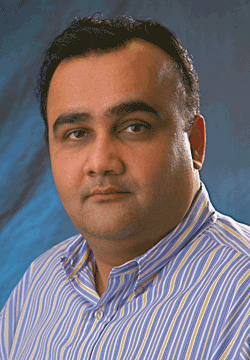The industry has done well during the last year’s economic upheavals, but still faces challenges
CONVENED AND MODERATED BY RICHARD COMERFORD
Last month, Electronics Products held its annual lighting and illuminations forum to assess the state of the industry. For the most part, participants said their companies had not been as significantly affected by the economic doldrums of the last year as others in the electronics industry, but they still faced a variety of challenges with respect to standardization and reliability.
Electronic Products: To start off, let’s take a look at what’s been happening with solid-state lighting in the past year, the highs and lows. Obviously, it’s been a tougher year economically than 2008. But we seem to be seeing light at the end of the tunnel now.
Paul Scheidt (Product Marketing Manager, LED Components Group, Cree) : Well, it’s been a good year for us, actually. The economic slowdown has not affected our business as much as it has other semiconductor companies. I guess we’ve been pretty fortunate in that respect.
We’ve seen a lot of upturn in business especially in the outdoor lighting space. That’s because there’s been a lot of publicly announced cities adopting SSL; the city of L.A. is the biggest one that has been announced, but there are a bunch of projects converting over to LED street lights in the U.S. and especially in Asia. Those programs, usually government-funded at this point, have really continued the adoption of LED lighting even through the economic downturn.

Electronic Products : Well, do you think that’s been helped at all by the fact that there’s actually been a downturn and people have been looking to try to save money on lighting?
Paul Scheidt : Well, there has been a couple of programs in a number of countries I mean, especially China and the U.S., government programs — stimulus funds or stimulus package, for example, the $700 billion package from the U.S. and some of that money has trickled down into energy-efficiency programs and those have been geared out. It’s just been the right time for LED lighting for street lights, park lights, those sorts of things.
George Henry (Chief Engineer, IC Division, Microsemi) : Microsemi is more in development mode than actual shipping mode for solid-state lighting right now; we’re transitioning into solid-state lighting. So we don’t have a large shipping backlog to refer to. But we do have tremendous interest from lots of large lighting companies and we are now partnering with several of them to develop new drivers and work with them.

Electronic Products : Well, how has the economic situation driven that or impacted that move into SSL?
George Henry : I don’t really know that the economic situation has been a factor. I think the main factor has been the interest of the lighting companies to make sure that they’re ready for the LED transition.
Faraz Hasan (Global Marketing and Business Development Manager, Circuit Protection Business Unit, Tyco Electronics) : From a circuit protection standpoint, we make and ship overvoltage, overcurrent, overtemperature devices to all the solid-state lighting manufacturing companies, companies that make the whole system, not just the LED.
In the last six months, we have seen an improvement in our orders and shipments, which I think is a good sign. And we’ve seen an increasing trend over the last two years for incorporating more protection, thus giving more reliability and more robustness in the whole system; that’s an ongoing process.
As Paul mentioned, a lot of new things are happening in China, Malaysia, and Taiwan for us, actually, and, obviously, in America. So those are the hot bells. We’ve seen a surge in orders, some of them small, some of them a little bigger. But it’s good news, I think.

Marc Dyble (Product Marketing Manager for Solid State Lighting Business Unit, OSRAM Optp Semiconductors) : From our standpoint, business is very good in this region and also in Asia in particular, as Paul was mentioning, a lot of development and first installation has been done in that region to really prove out the technology.
Here in the States, some of the projects funded by the National Gateway initiative from the Department of Energy have really lent themselves to showing the technology and being used in applications.
Overall, it’s been very, very good. A lot of companies have still moved forward quite well in this economic slowdown. Some have a tendency to wait a little bit, but others have taken it on full force and it’s been very good overall.

Rick Zarr (PowerWise Technologist, National Semiconductor) : It’s interesting. In the last year, I would say, we’ve been affected as well by the economic downturn. But we’ve been fairly lucky in that because a lot of companies are now seeing energy consumption as a large part of their budgets, and if it’s affecting the technology, like the LED drivers, LED manufacturers. This has been a good thing.

The high points for us have actually been a couple of interesting things.
There’s a lot of complementary technology, such as the Nuventix coolers and things like that, which has been introduced recently, and that has spurred a lot of replacement of standard light bulbs, like PAR-sized bulbs and things like that. So we’ve gone ahead and developed a series of drivers for a lot of these things, and we’ve seen a lot of upturn on that.
Another thing we’ve seen is a lot of people migrating away from CCFL to LEDs — and Paul and I have talked about this before for the backlighting for LCD TVs. I think that’s a new, emerging market. We’re seeing some areas like that driving our business as well.
Mike King (Manager, Visible LED Products, Optek) : We’re seeing a lot of customers approaching us with designs for outdoor lighting applications. Those have included the street lights and parking garages. We’re starting to receive interest in some interior lighting applications too.

The challenge with interior lighting is that, for fluorescent technology, the up-front costs are really a lot lower than for LED fixtures. But there are a few companies that are able to overcome those up-front costs. They see the benefits of lowering the operating cost of interior lighting.
So we’re continuing to see the lighting market grow. The economy hasn’t affected it as much as other semiconductor markets. We’re staying as busy as ever.
Ron Demcko (Applications Engineering Manager for the AVX Advanced Products Group and an AVX fellow) : Well, we’re shipping product, and shipping of existing product is certainly getting better as the economy improves and all of these new programs kick in.

The thing that’s encouraging, though, is the amount of new design work. Companies are looking for partners to either develop a product or help them in designing efficient end products. So things are looking very good and looking quite a bit better in the future.
Electronic Products : So, the past year hasn’t been totally horrible. It’s been good for a lot of people.
What the challenges are you facing now?
George Henry : Well, I have a long list, actually. As you know, Microsemi has always been a system house; we’re very system oriented, and we’re taking that approach now. You’ll be seeing some products coming out early next year, I think, that should be a little different than what’s on the market now. But we believe that LED adoption really requires the whole industry to take a complete system-design approach.
From what we hear, the high LED cost and the high driver cost primarily gets a payback through drastically reduced replacement / maintenance costs. While energy savings is an important factor, it seems to be secondary to maintenance.
Luckily, efficiency and long life for both LEDs and drivers go hand in hand at the design level. So if we can improve the efficiency of a LED, we reduce heat; if we improve efficiency of a driver, we reduce heat. And this reduces operating temperatures. And since MTBF, our mean time between failures, is exponentially increased with lower operating temperature, the industry can work together to improve all three of the issues, and these three levels are the LED first, the driver second, and then the luminaire.
So getting rid of that heat, I think, is key to adoption and early payback, which I think is limiting many applications right now.
Rick Zarr : Talking about the heat issue, we’ve had a lot of our customers asking us for ways to improve the efficiency. Obviously, when you reach the higher levels, up in the 90th percentile, it gets difficult to migrate to even higher levels of efficiency because you’re running up against the limits of the system.
But one thing that did show up which was kind of interesting is the fact that people are concerned about the longevity of the LEDs under thermal stress. So a lot of the manufacturers that are doing the high-brightness-type modules are providing thermal sensors.
And so one of the things that we’ve already released a product on and we’re releasing several others following this will be on thermal management. So actually, the driver actually has another secondary loop that monitors temperature to make sure that we never overstress the LED and improve its life in high-temperature conditions or even failure modes where a heat sink may have failed or a fan may have failed. So that’s one of the areas we see as emerging.
And like I mentioned, the challenge is we’re getting up against the limits of how far we can push the efficiency without altering the way we actually design drivers.
Faraz Hasan : With regard to temperature management, obviously we do a lot of work on that in terms of providing either thermal indication or thermal shutdown or dimming. Thermal management, from a circuit protection standpoint of view, is a challenge we are working on.
But one of the other things I see as happening is the lack of standardization in this industry. This is really a harmful for us because for a circuit protection, we need some kind of standardization. So if you take System X, Y, and Z, having X, Y, and Z components (LEDs, drivers, etc.), there is very little standardization in terms of temperature, current, voltages, the amount of surge they’re supposed to withstand, and so forth.
Now there are some UL and IEC standards, but really I think one of the challenges is to bring costs down would be to standardize more so that we can have high-scale, high-volume production of components and that kind of helps.
Ron Demcko : Well, I’d break the challenges up into two areas. One would be heat and heat management. So within heat management, it might be, something as simple as trying to make a connector that would allow a board, a carrier board to sit flatter on a substrate and have a maximized heat conduction through it. And we can also extend that to a capacitor, where we’d like capacitors to be more stable or even protection devices to be more stable over temperatures and over the harsh environments that these devices will have to go through. It really comes down to that.
Of course, the other one is the reliability and general improvement of the reliability and impact of components across — in those harsh environments. So that’s a recap of our two main pushes for this year.
Marc Dyble : From our perspective, cost is definitely a big driver, both at the product-side cost to our customers, but also from the production side. OSRAM has done a lifecycle cost analysis looking at the cost of raw materials, energy used to actually manufacture the parts and modules / components, to the actual operating costs involved in the lifetime of the product, and then the recycling cost at the tail end and we’ve compared those costs to the costs of other technologies.
Other challenges we see are color uniformity and color rendering of the product. We put a lot of emphasis into the phosphorus used in our LED packaging and technologies . It’s really helping to drive the color quality of the light coming from LED source compared to some of the incumbent light sources on that market.
And that’s tied with lifetime, really, denoting what failures are, how we overcome those, and what type of failures scenarios we see.
Then there’s standardization, which Hasan mentioned. The introduction of Energy Star and other types of governing bodies, ANSI and UL, to define what the lifetime of the LED source is, how do you denote failure (does an LED just turn off, is it the whole system that shuts down, what’s the depreciation over time). And looking at these, it’s apparent that thermal-optical feedback systems will be very important moving forward, both in maintaining the lumen output from the LED luminaire over time and with respect to color shift as well.
From a thermal standpoint, it’s important to reduce the thermal resistance of the packaging, making it as small as possible, and looking at how these LEDs interface with the board materials, the coefficient of thermal expansion. Especially with street lighting, we see a lot of temperature swing throughout the course of the day into the evening, and it’s important to make sure your ceramic-based LEDs are very robust in those environments.
So better product reliability is definitely a key focus for us in all these factors.
Paul Scheidt : Well, we’re just trying to move the industry forward in total performance of the LED components. Everybody wants brighter LEDs, more efficient LEDs, better quality-of-light LEDs, and lower cost all at the same time. So it’s a matter of trying to move the stick forward as far as performance of the LED goes, but at the same time keeping an eye on reducing the cost and making LEDs more accessible for more applications.
I think everybody has their eye on that. I get asked constantly about when a 60-W light bulb replacement is going to be viable. While we’ve got hundreds of LED applications that work today on an economic basis, that one’s fairly challenging. I think we’re getting near the point in this industry where we’ll be able to offer replacement for about a 40-W incandescent bulb. There are just significant thermal challenges and light-output challenges when you attempt to put LED light sources into an incandescent bulb form factor.
Electronic Products : But I don’t think anybody is expecting the initial costs of those 40-W bulbs to be comparable to the cost of an incandescent.
Paul Scheidt : Maybe, maybe not. I mean, these things will take about 80% less power. So there’s value in that; CFL has already proven that people are willing to pay more for energy efficiency.
Mike King : Probably, the biggest challenge is going to be the upfront costs associated with the LED-based lighting. We try to educate our customers as much as possible on the benefits of the reduced operating cost of an LED fixture versus the upfront cost; there is a return on the investment in two to three years.
But even with that, our customers are having a hard time overcoming the upfront costs of the LED lighting fixture itself. They’re used to the cost of the incandescent, the fluorescent lighting fixtures. When you present the LED fixtures, it sometimes gives them sticker-shock.
So there’s a lot of education going into that: why those up-front costs are so much and why they’re eventually going to come down. As you develop more and more fixtures, more demand for the LEDs come into play, that will lower the cost of the assembly itself. ■
Advertisement
Learn more about Electronic Products Magazine





